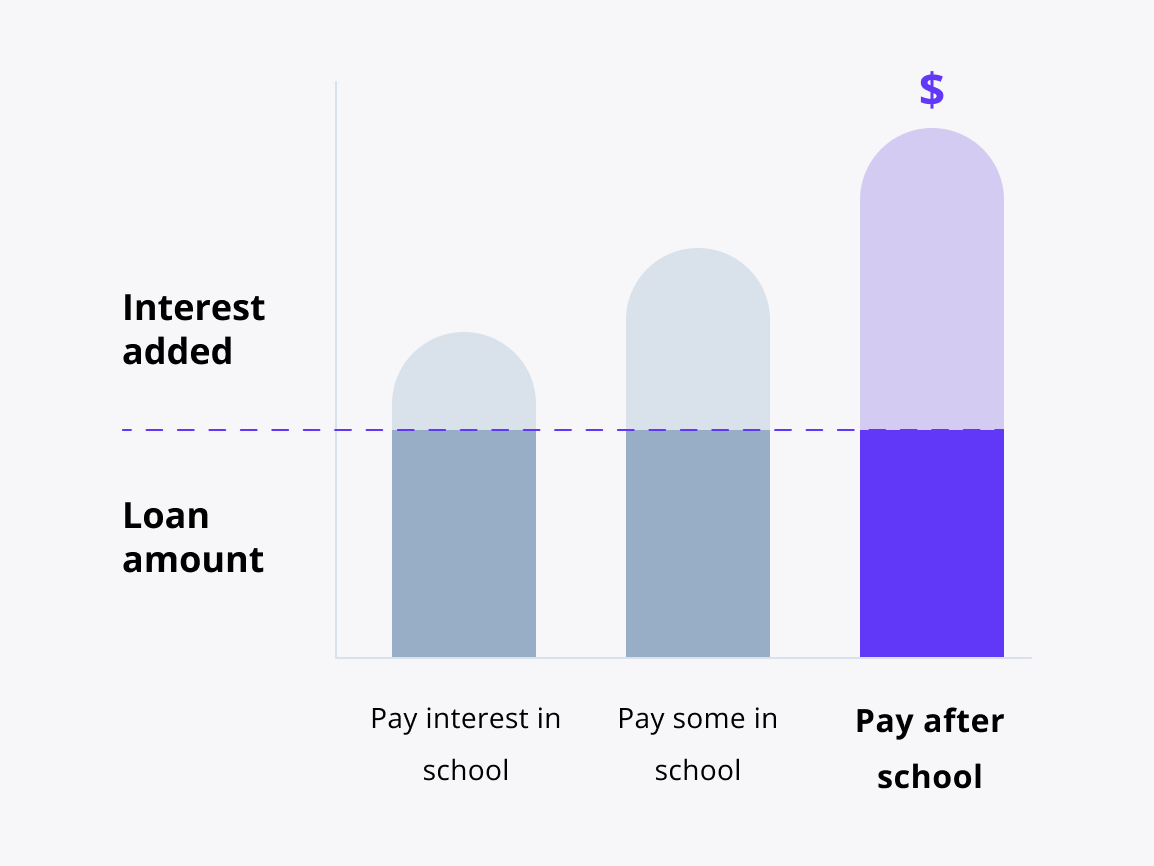You’re ready for your future with a career training student loan
Get the money you need to go all in on your professional training or trade school certificate course.
3.49%
to 16.15% APRfootnote 1
What are fixed rates?
Fixed means your interest rate never changes.
If you want a predictable monthly payment, this is the way to go.

4.54%
to 14.99% APRfootnote 1
What are variable rates?
Variable interest rates go up or down as the market changes.
This means your monthly payments may also change—they might be higher if interest rates rise and lower if they fall.

Career training student loan benefits
Breaking down your repayment options

Interest repayment option
How does it work?
You pay your interest every month you’re in school and in grace (the 6 months after).footnote 1
This is a great option if you want to save the most on your total loan cost.
Keep in mind:
You might have higher monthly payments, but the total cost of your loan may be lower.

Fixed repayment option
How does it work?
You pay $25 every monthfootnote 6 you’re in school and in grace.footnote 1
This is a great option if you want to make a dent in payments from the start.
Keep in mind:
Any interest you don't pay during school will be added to your principal amount (total borrowed) after grace.

Deferred repayment option
How does it work?
You have no scheduled payments while you’re in school and in grace.footnote 1
This is a great option if you want to focus on class and not on making loan payments.
Keep in mind:
The total cost of your loan may be higher because the interest you don’t pay on your loan while you’re in school and grace will be added to the original amount you borrowed (principal amount).
minutes
1. Tell us some basics
2. Choose your loan options
3. Sign and accept
Let’s make sure you’re ready
You’ll need a few things to apply like address, Social Security number (if you have one), and details about your school.
FAQs
Have other questions? We’re here to help.
1-877-279-7172
What is my school's cost of attendance?
You can estimate how much a whole year of school will cost using your school’s cost of attendance (COA), usually found on your financial aid offer or the school’s website.
The cost of attendance usually includes expenses like tuition, fees, books, meals, and transportation. Depending on the type of loan, your school may certify your loan amount. This means that your school confirms the loan amount to make sure you don’t borrow more than the cost of attendance.
Do I need a cosigner?
Most students don’t have the credit history to take out a loan by themselves. That’s where a cosigner can help. A cosigner is an adult with good credit who shares responsibility for the loan. By having a cosigner on the application, students’ chances of being approved may increase.
What’s the difference between a fixed and variable interest rate?
Fixed interest rate
The rate never changes, so you’ll have a predictable monthly payment amount.
Variable interest rate
The rate can go up or down as market conditions change. This means your student loan payments may also change—you might have lower payment amounts if interest rates fall and higher payments if interest rates rise.
What’s the difference between federal and private student loans?
Federal loans are provided by the government, while you take out a private loan from a bank like Sallie Mae, or a credit union. There are also differences in interest rates, repayment options, and other features.footnote 7
When you apply for a private loan, the lender must check your credit, including your borrowing/repayment history, to decide if you qualify for a loan. Many federal loans don’t require a credit check.
Why should I borrow for the entire school year?
You can apply just once a year with a single credit check and funds are sent (disbursed) for each term directly to your school. You can cancel any future disbursements as needed with no penalty. No interest is charged until money is sent to your school, so you can relax, knowing you've got the funds when you need them.
Can I qualify if attending school online, or less than half-time?
Yes! Whether you study online or on campus, you can borrow to cover your school costs, even if you're not a full- or half-time student. Our loan is a good choice if you find yourself in any of these situations:
- Attending school full-time, half-time, or less than half-time
- Online or on-campus classes
- Winter or summer classes
- Study abroad
- Professional certification courses
- A U.S. citizen or permanent resident enrolled in a participating school in a foreign country
- Students who are not U.S. citizens or permanent residents, including DACA students, residing in and attending school in the U.S. (with a cosigner who is a U.S. citizen or U.S. permanent resident)
How do you decide if I qualify for a student loan?
When you apply, we look at your history of borrowing money and paying it back on time. Lenders want to know how responsible you are with credit before approving your student loan application.
Many high school students haven’t had time to build up their own credit. That's why it can help to apply with a cosigner, a creditworthy adult who shares the responsibility of the student loan.
What information do I need when applying with a cosigner?
You and your cosigner will want to have your school information, amount needed (remember, you can use it to pay for school-certified expenses for the entire year) as well as your cosigner’s financial and employment information. Providing your social security number is optional. You or your cosigner may start the application, however, should your cosigner not be with you, we can send along an email with a link to their section of the application so they can fill it in later.